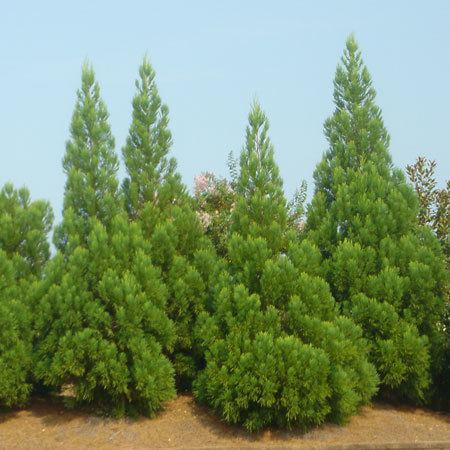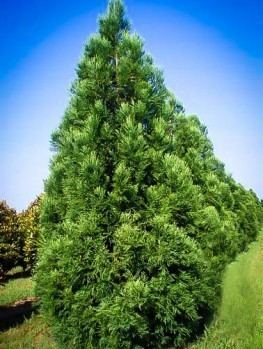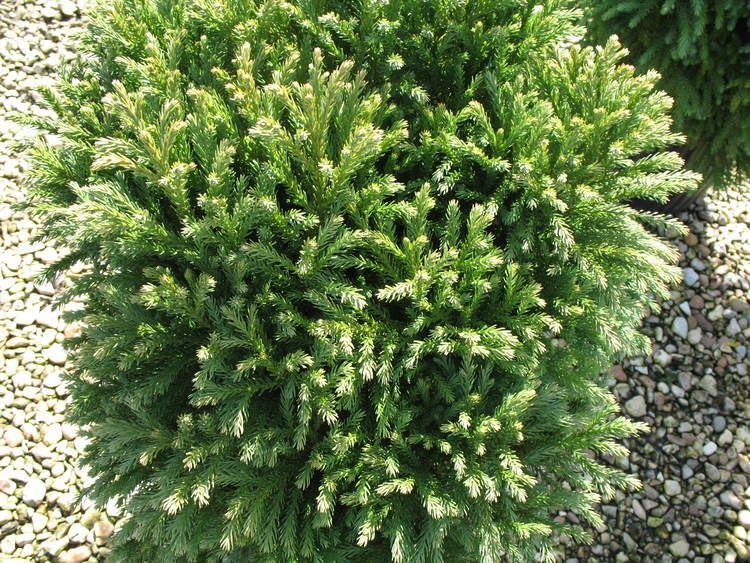Scientific name Cryptomeria Rank Genus | Division Pinophyta Species C. japonica Higher classification Taxodioideae | |
 | ||
Similar Hinoki cypress, False cypress, Cedar, Conifers, Coniferales | ||
Cryptomeria cypress die back
Cryptomeria (literally "hidden parts") is a monotypic genus of conifer in the cypress family Cupressaceae, formerly belonging to the family Taxodiaceae. It includes only one species, Cryptomeria japonica (syn. Cupressus japonica L.f.). It is endemic to Japan, where it is known as sugi (Japanese: 杉). The tree is called Japanese sugi pine or Japanese red-cedar in English.
Contents
- Cryptomeria cypress die back
- Yoshino japanese cryptomeria cryptomeria japonica yoshino evergreen screening tree
- Description
- Biology
- Mechanical properties
- Cultivation
- Symbolism
- References

Yoshino japanese cryptomeria cryptomeria japonica yoshino evergreen screening tree
Description
It is a very large evergreen tree, reaching up to 70 m (230 ft) tall and 4 m (13 ft) trunk diameter, with red-brown bark which peels in vertical strips. The leaves are arranged spirally, needle-like, 0.5–1 cm (0.20–0.39 in) long; and the seed cones globular, 1–2 cm (0.39–0.79 in) diameter with about 20–40 scales. It is superficially similar to the related giant sequoia (Sequoiadendron giganteum), from which it can be differentiated by the longer leaves (under 0.5 cm in the giant sequoia) and smaller cones (4–6 cm in the giant sequoia), and the harder bark on the trunk (thick, soft and spongy in giant sequoia).

Sugi has been cultivated in China for so long that it is frequently thought to be native there. Forms selected for ornament and timber production long ago in China have been described as a distinct variety Cryptomeria japonica var. sinensis (or even a distinct species, Cryptomeria fortunei), but they do not differ from the full range of variation found in the wild in Japan, and there is no definite evidence the species ever occurred wild in China. Genetic analysis of the most famous Chinese population of Cryptomeria japonica var. sinensis in Tianmu Mountain, containing trees estimated to be nearly 1000 years old, supports the hypothesis that the population originates from an introduction.

Cryptomeria japonica timber is extremely fragrant, weather and insect resistant, soft, and with a low density. The timber is used for the making of staves, tubs, casks, furniture and other indoor applications. Easy to saw and season, it is favoured for light construction, boxes, veneers and plywood. Wood that has been buried turns dark green and is much valued. Resin from the tree contains cryptopimaric and phenolic acid.
Biology
Cryptomeria grow in forests on deep, well-drained soils subject to warm, moist conditions, and it is fast-growing under these conditions. It is intolerant of poor soils and cold, drier climates.
Cryptomeria is used as a food plant by the larvae of some moths of the genus Endoclita including E. auratus, E. punctimargo and E. undulifer.
Sugi (and hinoki) pollen is a major cause of hay fever in Japan.
Mechanical properties
In dry air conditions, the initial density of Japanese cedar timber has been determined to be about 300–420 kg/m3. It displays a Young's modulus of 8017 MPa, 753 MPa and 275 MPa in the longitudinal, radial and tangential direction in relation to the wood fibers.
Cultivation
Cryptomeria japonica is extensively used in forestry plantations in Japan, China and the Azores islands, and is widely cultivated as an ornamental tree in other temperate areas, including Britain, Europe, North America and eastern Himalaya regions of Nepal and India. In the hills of Darjeeling and Sikkim, it is called dhuppi and the tall trees yield a light, soft wood that is extensively used for making planking for houses.
The cultivar 'Elegans' is notable for retaining juvenile foliage throughout its life, instead of developing normal adult foliage when one year old (see the picture with different shoots). It makes a small, shrubby tree 5–10 m (16–33 ft) tall. There are numerous dwarf cultivars that are widely used in rock gardens and for bonsai, including 'Tansu', 'Koshyi', 'Little Diamond', 'Yokohama' and 'Kilmacurragh.'
The following cultivars have gained the Royal Horticultural Society's Award of Garden Merit:
The wood is pleasantly scented, reddish-pink in colour, lightweight but strong, waterproof and resistant to decay. It is favoured in Japan for all types of construction work as well as interior panelling, etc. In Darjeeling district and Sikkim in India, where it is one of the most widely growing trees, C. japonica is called Dhuppi and is favoured for its light wood, extensively used in house building.
Its introduction in the Azores islands to be used commercially, resulted in the destruction of much of the original, now threatened, native laurel forest which affected an entire complex environment threatening many other species such as the priolo.
Symbolism
Sugi is the national tree of Japan, commonly planted around temples and shrines, with many hugely impressive trees planted centuries ago. Sargent (1894; The Forest Flora of Japan) recorded the instance of a daimyō (feudal lord) who was too poor to donate a stone lantern at the funeral of the Shogun Tokugawa Ieyasu (1543–1616) at Nikkō Tōshō-gū, but requested instead to be allowed to plant an avenue of sugi, so that "future visitors might be protected from the heat of the sun". The offer was accepted; the avenue, which still exists, is over 65 km (40 mi) long, and "has not its equal in stately grandeur".
